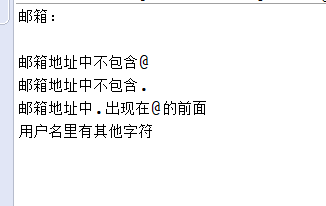上机练习
1.编写一个随机生成 10个 0(包括) 到 100 之间的随机正整数。
package snippet; import java.util.Random; public class text { public static void main(String[] args) { Random r = new Random(); for (int i = 1; i <= 10; i++) { System.out.print(r.nextInt(101) + ","); } } }

2.通过电子版教材或者视频,自学Date类和SimpleDateFormat类,用以下格式输出
系统当前时间
公元2020年05月28日:今天是2020年的第149天,星期四
package snippet; import java.text.SimpleDateFormat; import java.util.Date; public class text { public static void main(String[] args) { SimpleDateFormat sdf = new SimpleDateFormat("今年是Gyyyy年MM月dd日"); Date d = new Date(); SimpleDateFormat sd = new SimpleDateFormat("今天是Gyyyy年的第D天,E"); String s = sdf.format(d); String s1 = sd.format(d); System.out.println(s + ":" + s1); } }

3.输入一个邮箱地址,判断是否合法.如果合法,输出用户名.
合法:必须包含@ 和 . 并且.在@的后面 (用indexof)
用户名: 例如 dandan@163.com 用户名为dandan (用subString)
package snippet; import java.util.Scanner; import org.omg.Messaging.SyncScopeHelper; public class text { public static void main(String[] args) { PersonCreate(); } private static void PersonCreate() { Scanner sc = new Scanner(System.in); System.out.println("邮箱:"); String mail = sc.nextLine(); // 邮箱地址中不包含@或. if (mail.indexOf("@") == -1) { System.out.println("邮箱地址中不包含@"); } if (mail.indexOf(".") == -1) { System.out.println("邮箱地址中不包含."); } // 邮箱地址中含有多了@或. int a = 0; for (int i = 0; i < mail.length(); i++) { if (mail.charAt(i) == '@') { a++; } } if (a > 1) { System.out.println("邮箱地址中含有多余的@"); } int b = 0; for (int i = 0; i < mail.length(); i++) { if (mail.charAt(i) == '.') { b++; } } if (b > 1) { System.out.println("邮箱地址中含有多余的."); } // 邮箱地址中.出现在@的前面 int index = mail.indexOf('@'); int index1 = mail.indexOf('.'); if (index1 <= index) { System.out.println("邮箱地址中.出现在@的前面"); } // 用户名里有其他字符 String R = "\w + @ \w +\.\w{2,3} "; if (!(mail.matches(R))) { System.out.println("用户名里有其他字符"); } } }

